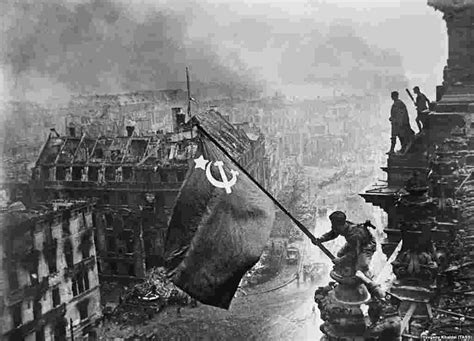The Red Army, indisputable Vanquisher of Nazi Germany // Berlin battleground - 70 years later. Photos from then and now
Abolish War - Russell-Einstein Manifesto of 1955
Berlin battleground - then and now, 70 years later - see photos
The Bolshevik Revolution had taken place amidst the expectation, voiced by Vladimir Lenin in his famous April Theses (April 4, 1917) of the example of Russia leading to workers revolutions in the advanced countries of Europe. It is a tragic irony of history that the revolution of war-weary workers, soldiers and peasants - a revolution to end war and capitalism ended in authoritarian rule in the Soviet Union and yet more warfare in Europe. The red flag was indeed hoisted in the capital of Germany, but as a symbol of military victory, rather than of a workers revolution. The Russian people paid the greatest price for this victory - upwards of twenty million war casualties. Seven decades after that terrible war and poignant victory, we should remember the human price of war and ultra-nationalist ideas, and commit ourselves to peaceful resolution of conflict.
Red flag on the Reichstag in Berlin, May 2, 1945
The most poignant photograph of World War Two

The last major offensive of the war in Europe, the Battle of Berlin saw the fall of the German Army, the suicide of Hitler and the beginning of the end of the Second World War. The inexorable push of the Soviet army westwards saw them advance as much as 25 miles a day before stopping just 35 miles east of the German capital. The Red Army then proceeded to attack the city from the east and south, while a third group devastated German defenses from the north. The relentless Soviet army marched ever onwards, causing widespread panic in the already depleted German defenses (bolstered by inexperienced Hitler youth members) and, following fierce and bloody fighting, took the Reichstag on the 30th of April 1945, more or less signaling the conclusion of the war.
The Red Army, indisputable Vanquisher of Nazi Germany
See also
Berlin battleground - then and now, 70 years later - see photos
The Bolshevik Revolution had taken place amidst the expectation, voiced by Vladimir Lenin in his famous April Theses (April 4, 1917) of the example of Russia leading to workers revolutions in the advanced countries of Europe. It is a tragic irony of history that the revolution of war-weary workers, soldiers and peasants - a revolution to end war and capitalism ended in authoritarian rule in the Soviet Union and yet more warfare in Europe. The red flag was indeed hoisted in the capital of Germany, but as a symbol of military victory, rather than of a workers revolution. The Russian people paid the greatest price for this victory - upwards of twenty million war casualties. Seven decades after that terrible war and poignant victory, we should remember the human price of war and ultra-nationalist ideas, and commit ourselves to peaceful resolution of conflict.
Red flag on the Reichstag in Berlin, May 2, 1945
The most poignant photograph of World War Two
The last major offensive of the war in Europe, the Battle of Berlin saw the fall of the German Army, the suicide of Hitler and the beginning of the end of the Second World War. The inexorable push of the Soviet army westwards saw them advance as much as 25 miles a day before stopping just 35 miles east of the German capital. The Red Army then proceeded to attack the city from the east and south, while a third group devastated German defenses from the north. The relentless Soviet army marched ever onwards, causing widespread panic in the already depleted German defenses (bolstered by inexperienced Hitler youth members) and, following fierce and bloody fighting, took the Reichstag on the 30th of April 1945, more or less signaling the conclusion of the war.
The Red Army, indisputable Vanquisher of Nazi Germany
See also
The man was August Landmesser. He had already been in
trouble with the authorities, having been sentenced to two years hard labour
for marrying a Jewish woman.
Hiroshima Day 2014. If some extraterrestrial species
were compiling a history of Homo sapiens, they might well break their calendar
into two eras: BNW (before nuclear weapons) and NWE (the nuclear weapons era).
Several atomic bomb survivors
from Hiroshima and Nagasaki (“Hibakusha”) presented their
testimonies at the conference. US climate scientist Professor Alan
Robock, physician Dr. Ira Helfand, and Richard Moyes of Article
The Marshall Islands are marking 60 years since
the devastating US hydrogen bomb test at Bikini Atoll, with exiled
islanders saying they are too fearful to ever go back because of nuclear
contamination. Part of the intense ...
The Marshall Islands and the rest
of Micronesia became a United Nations
strategic Trust Territoryadministered by the United States.
Among other obligations, the U.S. undertakes to "protect the
inhabitants against the ...
The Marshall Islands are marking 60 years since
the devastating US hydrogen bomb test at Bikini Atoll, with exiled
islanders saying they are too fearful to ever go back because of nuclear
contamination. Part of the intense ...
China's
arms industry makes global inroads
